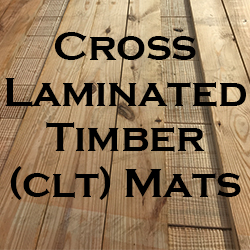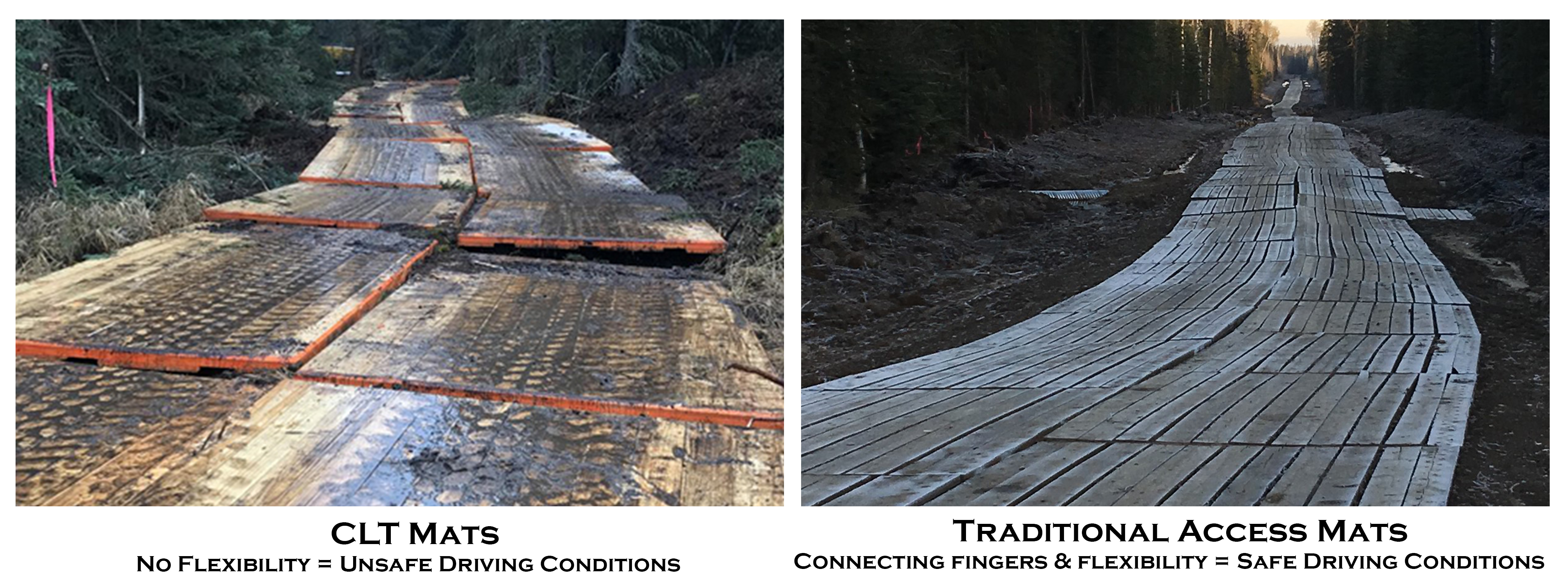1) Is mat strength more important than flexibility?
When it comes to access matting, it is important to understand that strength cannot only be measured in pounds of pressure. Because access mats (aka swamp mats) are used to cross rugged terrain, a significant amount of flexibility or deflection, is needed for the mat to conform to uneven surfaces as trucks and equipment drive along the matting right-of-way.
2) Will you be working in wet/snowy conditions?
According to The Engineered Wood Association’s (APA) CLT Product Report – PR-L314C – Structurlam Products LP: “Structurlam CrossLam products shall be limited to dry service conditions”
3) Safety concerns related to extremely slippery mat surfaces
Rain, dew, frost, ice and snow all result in the mats surface becoming very slick. This has been known to result in numerous safety issues for both people and equipment
4) Cleaning challenges
Although the surface of CLT mats are flat, the bottoms, which come in direct contact with soil organics, still contain grooves. As a result, CLT mats face the same challenges of a traditional mat; however, no advanced mat cleaning technology exists for CLT mats, as they do for traditional access matting.
5) Laying Orientation
Most CLT mats do not contain interconnecting fingers and are designed to be laid horizontally. This laying technique was rejected long ago by traditional matting companies as the uneven weight distribution of vehicles and equipment driving along the mats causes the mats to kick up, resulting in damage to the undercarriage.
6) Size differences from traditional matting fleets
For those CLT mats that do have interconnecting fingers, because of the lack of spacing on the bottom side of the mat, the fingers do not line up with traditional matting fleets.
7) High damage costs
Because a CLT mat is glued together, once it is damaged they cannot be repaired – the entire mat must be replaced
8) Environmental Impacts of Polyurethane Adhesives
The most common glue used in engineered wood products is known as PUR (one-component polyurethane). Purbond is a single component Polyurethane adhesive. One of the benefits of Purbond is that it is formaldehyde free. However, formaldehyde free does not necessarily mean sustainable. Factors to consider when evaluating impact in terms of emissions in the atmopshere include: the production of the adhesive, the application to produce CLT, and the disposal of the product. For more information read Tommaso Scalet’s study: Cross Laminated Timber as Sustainable Construction Technology for the Future
9) End of life challenges
Repurposing CLT mats becomes a challenge as a result of the industrial adhesives. One common practice for the recycling of access mats is to have them chipped and use the old timber for fuel. “To recycle CLT, it would be necessary to split each lumber layer and extract the glue from them. After that the wood could be recycled or composted and the glue eventually cleaned and reused. The problem is basically that the process would not only take a lot of time and resources but also there are no technologies that could carry out the process in a large scale.” (Tommaso Scalet)
10) CLT mats are a relatively new product
With any new product, it takes time to determine how to make the most efficient and effective product. As with anything, before making any decisions, make sure you understand what you are purchasing. If you have any questions about CLT mats or Traditional Access Mats, fill out the form below and one of our matting professionals will be happy to assist you.

